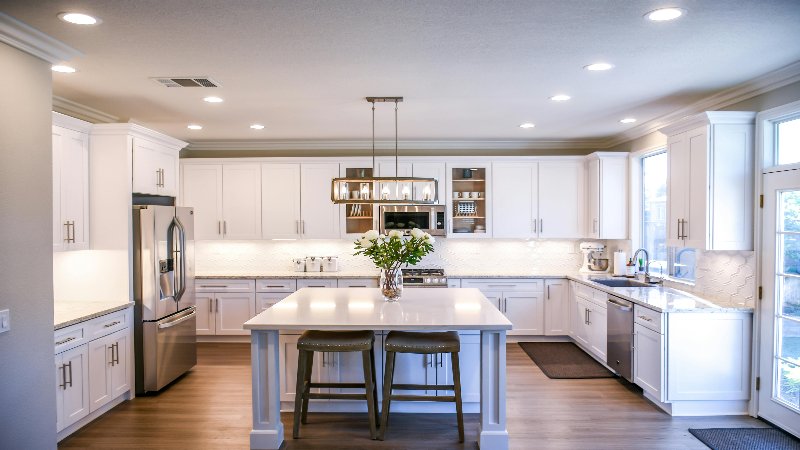Few decisions carry as much weight for a homeowner or property manager as selecting new cabinets. Purchasing is conducted in two main ways: wholesale and retail. Recognizing these disparities enables buyers to make informed decisions, taking into account their specific needs, budget, and project size.
Price and Value Comparison
Wholesale cabinets are less expensive than over-the-counter cabinets. The discrepancy in pricing stems from wholesalers selling directly to contractors or large-volume buyers. However, retailers also factor in the costs of showroom displays, sales staff, marketing, and so on.
Instead, consumers will likely pay a higher price per cabinet at retailers than they would through a wholesaler. Due to these savings, wholesale suppliers have always been appealing to budget-conscious buyers.
Product Variety and Selection
Retail stores offer a wide range of styles, materials, and finishes for cabinets. It can be comforting to customers to see and touch these cabinets before they make a decision. While wholesalers may have limited display options, they do offer a larger catalog.
Some wholesalers offer a far greater selection for builders and remodelers, even though many sell in bulk. Ultimately, shoppers must balance the advantages of seeing products in person with those of a wider catalog.
Customization Options
Most retailers offer customization options, allowing buyers to choose special finishes, colors, or even hardware for their cabinets. Special orders actually take more time to ship, but they offer a customized approach. Some wholesalers specialize in custom requests, while others focus on standard sizes and configurations, enabling them to produce their products quickly and easily for retailers.
Projects with more unique sizing or features may be a better fit in retail channels through more flexible processing. However, other wholesale suppliers may also have custom orders, depending on their business model.
Quality and Construction
Not all cabinets are created equal—the quality of cabinets found in retail and wholesale markets varies widely. Retailers often make reference to solid wood construction, soft-close hinges, or dovetail joints. Such features make it attractive to buyers looking for durable products.
While some wholesalers use low-cost materials to appeal to budget-minded shoppers, others can offer cabinets of a like or comparable quality. Understanding product specifications and construction methods enables purchasers to make fair comparisons. Having samples or specifications that detail the exact final purchase ensures the final order comes out or is even better than expected.
Service and Support
In a retail store, access to direct and hands-on assistance is often offered during the shopping process. Customers may receive design consultations, installation recommendations, and after-sales support. These can make planning and execution easier for those remodeling for the first time or homeowners in general.
Distributors, on the other hand, frequently cater to contractors with design experience or installation teams. Wholesalers sometimes offer support or guidance, but it is not as personal as that provided by retail. Shoppers should determine what type of planning and installation they are comfortable with before making a purchase.
Lead Times and Delivery
Most retailers maintain a level of stock on hand, so ordering a popular cabinet style can help shorten lead times. Special orders for decorative blinds or customizations can extend delivery timelines. Many wholesale suppliers operate from warehouses or direct shipping networks, leading to faster fulfillment for generic models.
Bulk orders or customized requests, however, may take longer. It is best to verify the delivery schedules before finalizing a supplier to prevent any delays in the project.
Installation Resources
A few retailers also work with local installers or offer leads to individuals with solid references. This setup assists buyers who prefer not to deal with finding an installer. The wholesaler does not provide direct installation services; instead, it depends on the buyer or the contracting party.
This arrangement is why remodelers or contractors with experience usually shop with wholesalers. Customers purchasing through wholesale suppliers must account for the fact that they will likely need outside help and expertise in installing those supplies.
Warranty and Return Policies
Many retailers offer tangible warranty terms and easy return policies. This ensures buyers’ peace of mind from defects or dissatisfaction. Warranty terms can differ when it comes to wholesale suppliers, bulk purchases, or clearance products.
By comparing products according to warranty length, coverage, and return policy, buyers can safeguard their investments. It is effective to emphasize that reading all the terms before purchasing helps to avoid misunderstandings that can emerge in the future.
Conclusion
Knowledge of the differences between wholesale and retail kitchen cabinets helps buyers evaluate the alternatives and choose the ones that meet their project needs. Choosing the right thing to do, in terms of price, quality, service, and support, means your kitchen renovation will go as smoothly and be as satisfying as possible.
See Also: Benefits of Choosing Quartz for Your Kitchen Renovation
